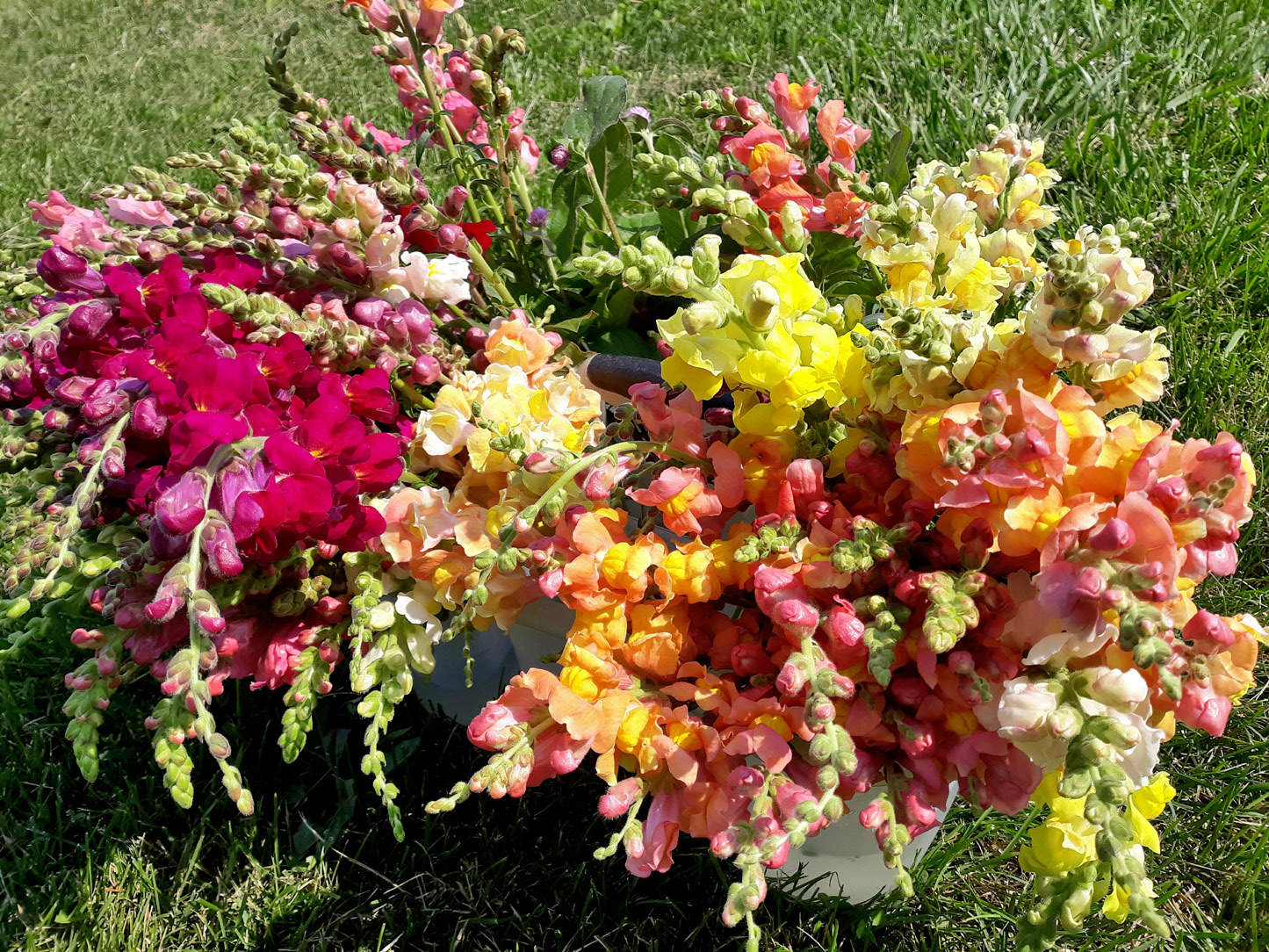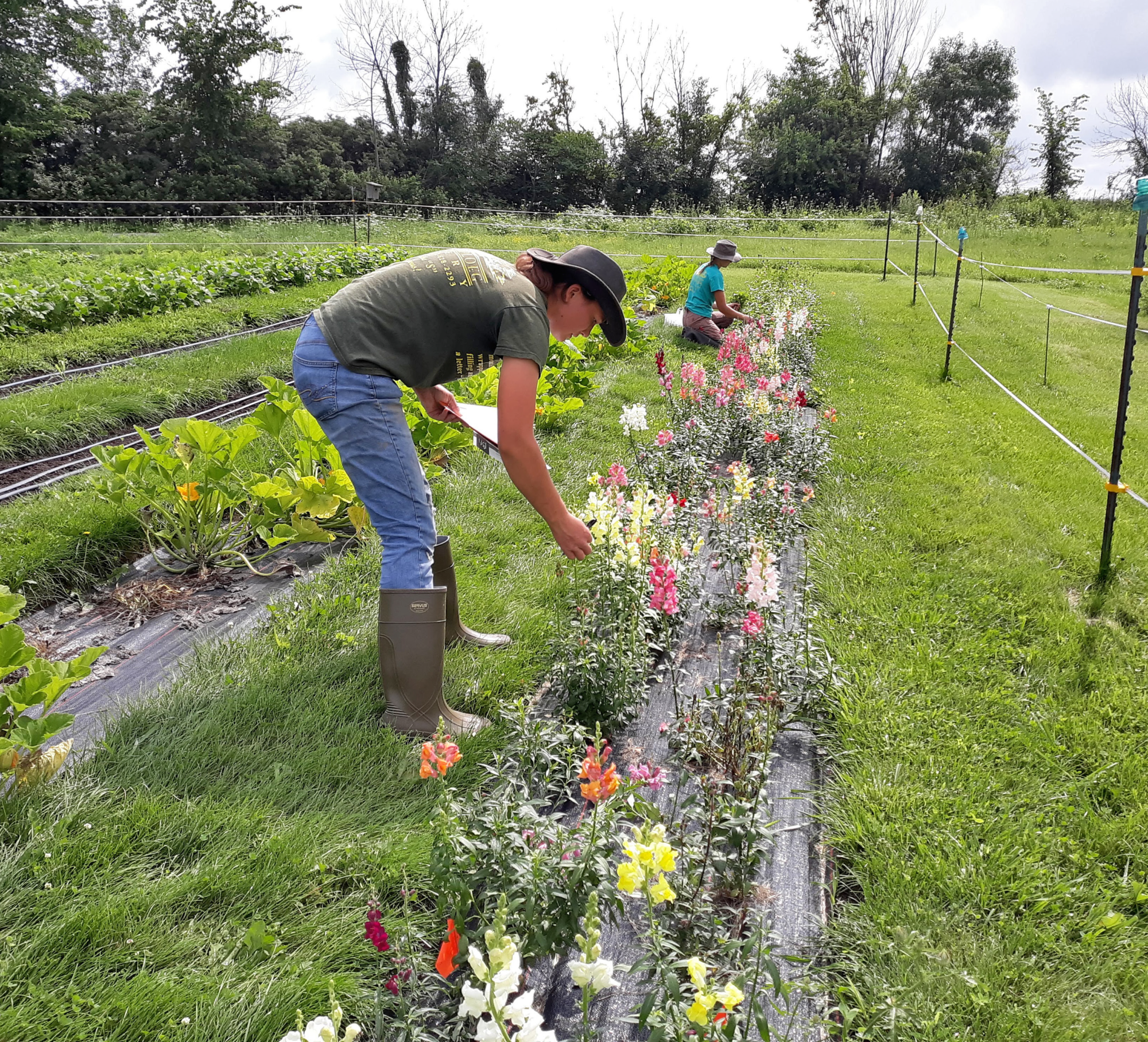This project was funded by Ceres Trust.
In a Nutshell:
- Jill Beebout and Anna Hankins & Shae Pesek selected three snapdragon varieties and evaluated their performance in terms of marketable stems produced for inclusion in bouquets.
Key Findings:
- Beebout saw no difference in performance among the three varieties she trialed (Rocket Mix, Tall Deluxe Mix and Costa Mix).
- Rocket Mix was the clear winner at Hankins & Pesek’s farm; it outperformed Chantilly Purple and Madame Butterfly by nearly twofold.
Background
Community Supported Agriculture, or CSA, are an important business model that many vegetable and flower farmers use. For flower farmers, CSAs mean weekly bouquets or arrangements that are prepared and given to customers that paid for a certain number of weeks (shares) ahead of time. This investment from customers provides farmers an income before the growing season begins which allows producers to buy necessary materials such as equipment, plugs and seeds. Flower CSAs are appreciated by floral shops, wedding companies and people who like to have flowers displayed in their home. For cut-flower farmers, it is important to have flowers in bloom through the whole season and preferably that can fill out bouquets. This means that many varieties and types of flowers are grown as they bloom at different times.
The objective of this project was to determine, by farm, which of three snapdragon varieties produced the most number of marketable stems for cut-flower production. Anna Hankins said, “As we grow our flower CSA, determining field grown flowers that can fill our early season bouquets is very important. This trial will help us look at our varieties and practices more carefully to begin answering that question.” Hankins had participated in the past in trials during her time living at Local Harvest CSA, but Hankins’ farming partner, Shae Pesek, had never participated in one. Hankins and Pesek hoped this trial will develop a scientific lens for decision making at their farm. Jill Beebout, who also participated in the trial, said, “Growing cutting flowers is still a fairly new enterprise for us and we’ve just defaulted to the same standby variety. This trial gives us a push to expand our familiarity with other varieties and increase our cutting beds.”
Methods
Design
Each of the farmers planted four replications of three snapdragon varieties of their choosing for a total of twelve plots. The three varieties chosen by Jill Beebout were Costa Mix, Rocket Mix and Tall Deluxe Mix. The three varieties chosen by Hankins and Pesek were Rocket Mix, Madame Butterfly and Chantilly Purple. Hankins & Pesek’s experimental design is depicted in Figure A1; Beebout used a similar design for the three varieties she trialed. Management info for both of the farms can be found in Table 1.
Measurements
Cooperators counted the number of marketable stems for each plot as they harvested throughout the growing season. At Beebout’s (south-central Iowa), harvest occurred between May 28 and July 16; at Hankins & Pesek’s (eastern Iowa), this occurred between June 8 and June 30.

Shae Pesek pinching back snapdragon plants on May 23, 2021 (about one month after transplanting). Pinching helps to encourage multiple branches and blooms.
Data analysis
To rank the effect of variety on marketable stems at both farms, we calculated Tukey’s least significant difference (LSD). If the difference in yield for any two varieties was greater than or equal to the LSD, we confirm that variety had a statistically significant effect on yield. On the other hand, if the difference in yield was less than the LSD, we consider the varieties to be statistically similar. We used a 95% confidence level to calculate the LSDs, which means that we would expect our rankings to occur 95 times out of 100. We could make these statistical calculations because the farmers’ experimental designs involved replication and randomization of their treatments (Figure A1).
Results and Discussions
Economic Impact
At Beebout’s, all three varieties trialed performed statistically similarly (Figure 1). Averaged across all varieties, Beebout harvested 81 stems per plot over the course of her season (May 28 to July 16).
At Hankins & Pesek’s, the Rocket Mix variety was the statistical standout, scoring roughly twice as many stems as either of the other varieties trialed (Figure 2).
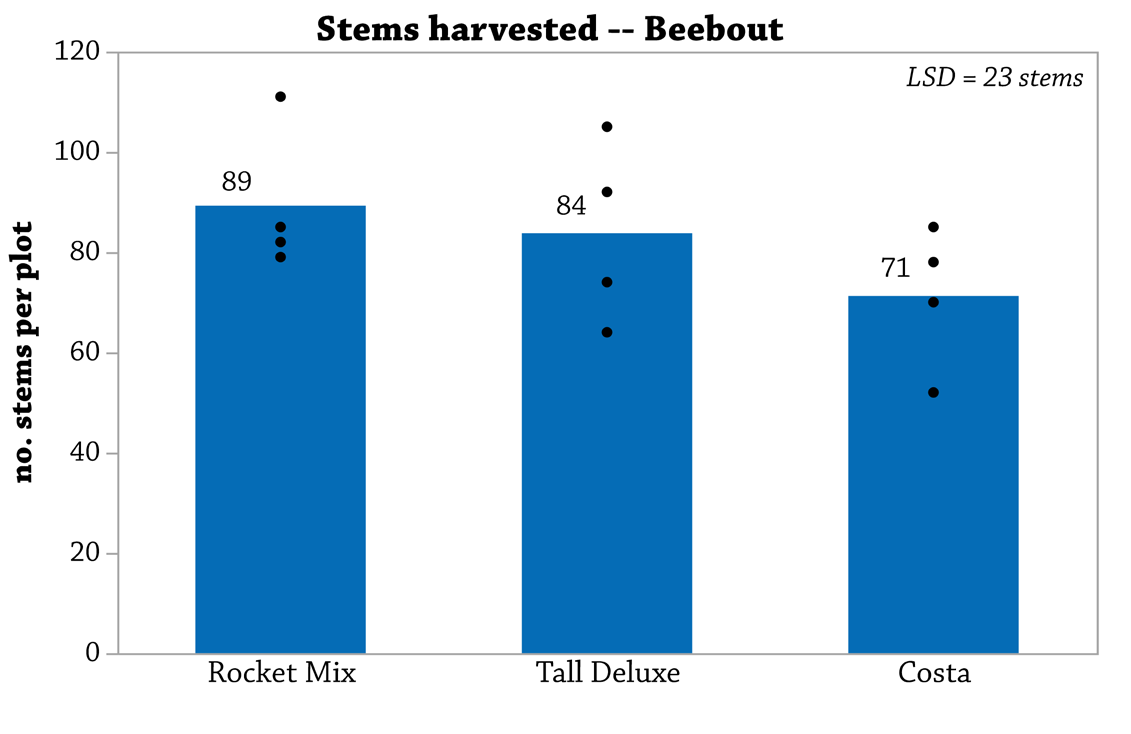
FIGURE 1. Marketable stems harvested for each variety of snapdragons at Jill Beebout’s in 2021. Dots represent individual plot results while bars and values represent the variety average. Because none of the variety averages differed by more than the least significant difference (LSD = 23 stems), we considered the varieties to be statistically equal with 95% confidence.
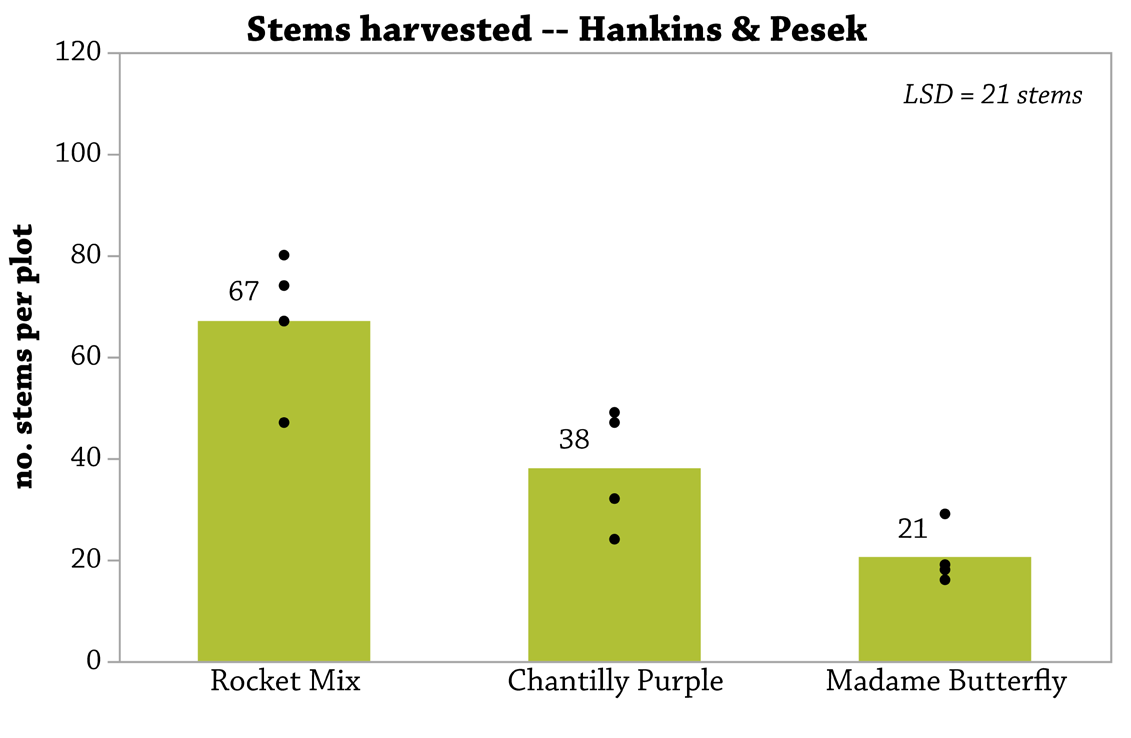
FIGURE 2. Marketable stems harvested for each variety of snapdragons at Anna Hankins & Shae Pesek’s in 2021. Dots represent individual plot results while bars and values represent the variety average. If variety averages differed by more than the least significant difference (LSD = 21 stems), we considered those varieties to be statistically different with 95% confidence. If variety averages did not differ by more than the LSD, we considered those varieties statistically equal.
Conclusions and Next Steps
Beebout and Hankins & Pesek each learned more about growing snapdragons on their farms. Reflecting a sentiment also shared by Hankins and Pesek, Beebout said, “This trial gave us the framework to gather the info we were curious about.” Beebout was glad to try some varieties she had little previous experience with. Because she observed no statistical differences among the varieties she trialed, Beebout plans on selecting any of Rocket Mix, Tall Deluxe or Costa to their regular snapdragon crop in the future. Beebout put her farm crew chief in charge of this trial and valued familiarizing her crew with the experimental process of a scientific on-farm trial.
“This trial really showed us and affirmed to us that we need to spend more time and energy thinking about the varieties we’re growing, where we are sourcing seeds, and the conditions of our seedlings in order to produce the highest quality flowers,” Hankins said. They are curious to evaluate more snapdragon varieties next season. Hankins added: “The most valuable aspect of this trial was getting our feet wet with the Cooperators’ Program! It sparked our own interest in future trials related to flowers but it also got Shae’s family excited about being potential cooperators interested in horticulture and row crop trials!!”
Appendix- Trail Design and Weather Conditions

FIGURE A1. Example of experimental design used by the farmers in the trial. This design allowed for statistical analysis of the results.
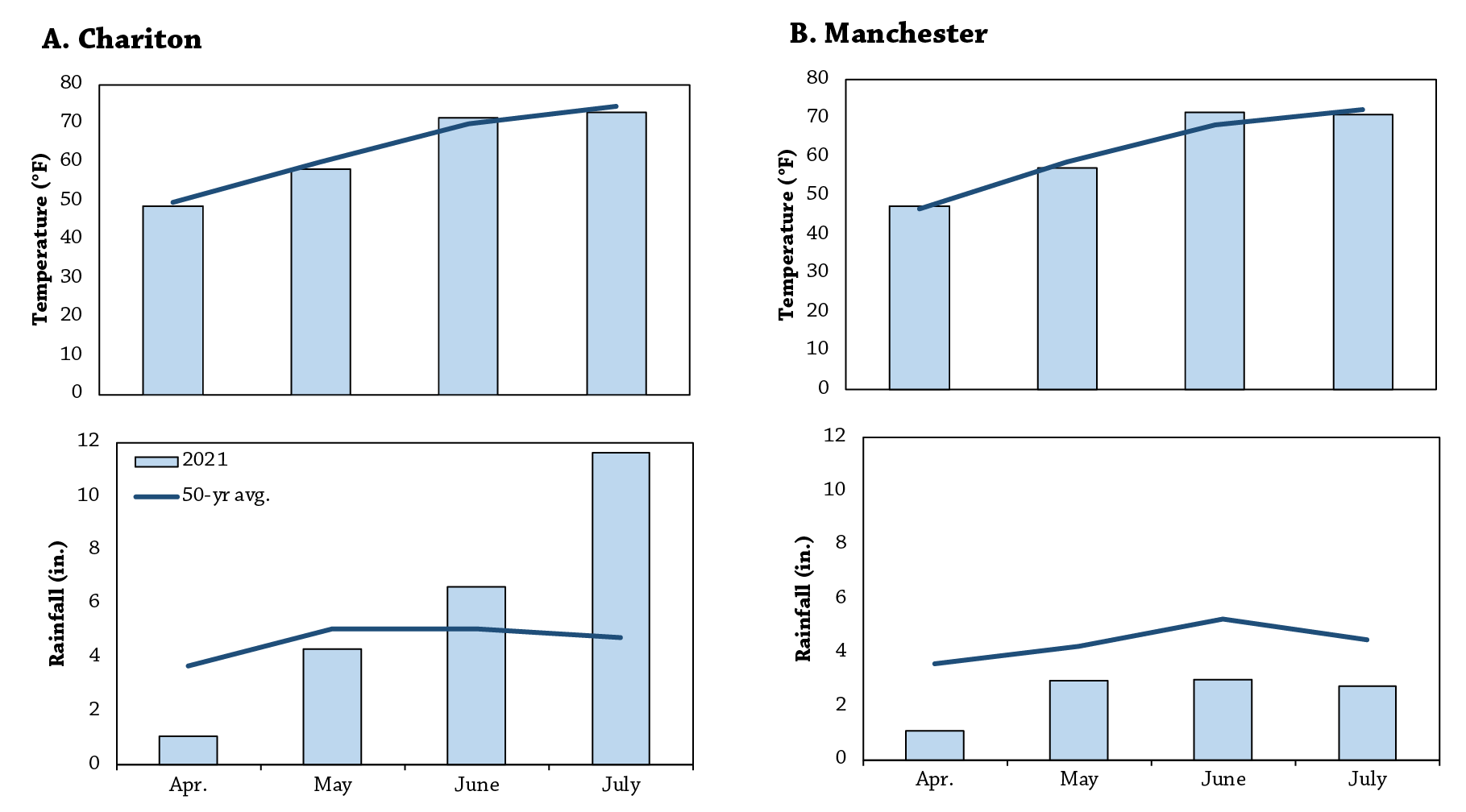
FIGURE A2. Mean monthly temperature and rainfall for April through July and the long-term averages at the nearest weather stations to each farm.[1] A) Beebout (Chariton); B) Hankins & Pesek (Manchester).
References
- Iowa Environmental Mesonet. 2021. Climodat Reports. Iowa State University. http://mesonet.agron.iastate.edu/climodat/ (accessed August 2021).


